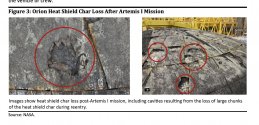The Japanese lunar lander (SLIM) survived another lunar night.
You are using an out of date browser. It may not display this or other websites correctly.
You should upgrade or use an alternative browser.
You should upgrade or use an alternative browser.
NASA & World Space Exploration...News, Views, Photos & videos
- Thread starter bd popeye
- Start date
Likely has to do with the low performance of the falcon second stage, being one RP-1/lox engine, and not a purpose built hydrogen stage like centaur. A falcon heavy with centaur could do it I bet.NASA says its Gateway module is too heavy for Falcon Heavy despite being only 20 tons (for reference that is lighter than Tianhe core module and Russia's Zvesda module)
View attachment 128734
This comes at a time when a separate report highlights possible overstatement of even Starship's capabilities as Elon Musk is now saying Flight 3 is only targeting 40-50t to orbit.
Isn't the Lunar Gateway supposed to be a space station orbiting the Moon or somewhere in cislunar space?
That makes delivering it to the target more difficult.
It's a space station in NRHO, sort of a 'go-to' point for Artemis missions to and from Earth.
According to the report, NASA is currently ordering its contractors to shave off as much mass as possible on the Gateway modules which will no doubt affect mission capabilities, even though it should be well within what SpaceX claims it can do on its website (something like 63t to LEO and 26t to GTO!).
Likely has to do with the low performance of the falcon second stage, being one RP-1/lox engine, and not a purpose built hydrogen stage like centaur. A falcon heavy with centaur could do it I bet.
That and a structural issue. Falcon Heavy cannot accept a third stage. If I was a betting man I'd wager this is what China is hard at work trying to solve on its CZ-10.
Falcon's thin, long, "aerodynamic" design improves payload capacity, but at the cost of leaving little room for modification of the spacecraft. Changes to the vehicle such as increasing the length of the payload or adding another stage on top (both important enhancements that are required by important government customers) would cause the vehicle to be unstable in flight. Most other rockets are designed to leave room for further changes to the architecture.
The reality is there are structural issues that make it very difficult to fly payloads with heavy mass or irregular shapes like most of NRO's heavy spy satellites or the Gateway's PPE and HALO modules. Its length-width ratio (idk what the specific term is called in rocketry) is near its maximum and has little room for modification without affecting vehicle dynamics.
The Falcon 9 was originally designed to be able to be transported by truck to the launch site. Its physical diameter is basically the size limit of what you can transport by flatbed truck.Falcon's thin, long, "aerodynamic" design improves payload capacity, but at the cost of leaving little room for modification of the spacecraft. Changes to the vehicle such as increasing the length of the payload or adding another stage on top (both important enhancements that are required by important government customers) would cause the vehicle to be unstable in flight. Most other rockets are designed to leave room for further changes to the architecture.

This is a hard limitation because the width of road lanes is fixed. To make the rocket wider you need to either switch to barge transportation, or build the rockets right next to the launch site. NASA chose the former with the Saturn V and Shuttle, SpaceX chose the latter for Starship.
Increasing the width of the rocket will impact the economics of the vehicle. It means they have to build a new rocket factory, and new testing facilities.
They could just use inflatable modules for the Gateway. The satellites might be an issue, if the diameter of the rocket is much smaller than the diameter of the main telescope mirror or something. Then you need to have an expensive origami contraption like the James Webb Space Telescope.The reality is there are structural issues that make it very difficult to fly payloads with heavy mass or irregular shapes like most of NRO's heavy spy satellites or the Gateway's PPE and HALO modules.
This is called the fineness ratio in the industry.Its length-width ratio (idk what the specific term is called in rocketry) is near its maximum and has little room for modification without affecting vehicle dynamics.
TerraN_EmpirE
Tyrant King
Apparently SpaceX is launching its own EVA suit
If you’re confused. The suits that SpaceX has used for Commercial Crew launches are a launch and reentry suit. The difference is major but most Sci-fi movies don’t bother to show it. Basically a launch and entry suit is a pressure suit. It’s just a fabric bag that is pressurized in the event of pressure loss inside the spacecraft. It’s like the suits worn in very high altitude flights… really it is the suit worn in high altitude flight.
Now EVA suits are designed for operating in space outside the space craft. They are designed as personal spacecraft. If you have ever listened to a space skeptic or a moon denier they will at some point point out that a space suit made of fabric should be swollen up like a balloon if you are in space or on the moon. Surprisingly they are correct. It was discovered by both the U.S. and Soviets in the exact same way when the first attempts at a space walk took place that the pressure suit based suits do expand and are as such hard to move in. So back then they just reduced the amount of air in the suit to about a third. Later suits were often designed with articulation points and more like a suit of armor for a European knight with hinged arms, knees and fingers so that the suit would retain a shape and allow movement.
SpaceX’s new suit also has a Heads up display.
On that subject
If you’re confused. The suits that SpaceX has used for Commercial Crew launches are a launch and reentry suit. The difference is major but most Sci-fi movies don’t bother to show it. Basically a launch and entry suit is a pressure suit. It’s just a fabric bag that is pressurized in the event of pressure loss inside the spacecraft. It’s like the suits worn in very high altitude flights… really it is the suit worn in high altitude flight.
Now EVA suits are designed for operating in space outside the space craft. They are designed as personal spacecraft. If you have ever listened to a space skeptic or a moon denier they will at some point point out that a space suit made of fabric should be swollen up like a balloon if you are in space or on the moon. Surprisingly they are correct. It was discovered by both the U.S. and Soviets in the exact same way when the first attempts at a space walk took place that the pressure suit based suits do expand and are as such hard to move in. So back then they just reduced the amount of air in the suit to about a third. Later suits were often designed with articulation points and more like a suit of armor for a European knight with hinged arms, knees and fingers so that the suit would retain a shape and allow movement.
SpaceX’s new suit also has a Heads up display.
On that subject
Apparently SpaceX is launching its own EVA suit
If you’re confused. The suits that SpaceX has used for Commercial Crew launches are a launch and reentry suit. The difference is major but most Sci-fi movies don’t bother to show it. Basically a launch and entry suit is a pressure suit. It’s just a fabric bag that is pressurized in the event of pressure loss inside the spacecraft. It’s like the suits worn in very high altitude flights… really it is the suit worn in high altitude flight.
Now EVA suits are designed for operating in space outside the space craft. They are designed as personal spacecraft. If you have ever listened to a space skeptic or a moon denier they will at some point point out that a space suit made of fabric should be swollen up like a balloon if you are in space or on the moon. Surprisingly they are correct. It was discovered by both the U.S. and Soviets in the exact same way when the first attempts at a space walk took place that the pressure suit based suits do expand and are as such hard to move in. So back then they just reduced the amount of air in the suit to about a third. Later suits were often designed with articulation points and more like a suit of armor for a European knight with hinged arms, knees and fingers so that the suit would retain a shape and allow movement.
SpaceX’s new suit also has a Heads up display.
On that subject
I am surprised at how thin it looks. It honestly doesn’t look much different from their current re-entry suit. Much smaller then the suits Astronauts currently use when operating on the outside of the ISS.
TerraN_EmpirE
Tyrant King
The suit likely had to be made to fit in the chairs of the Dragon capsule. As such they designed these as close fitting as possible. They have to fit in the chairs as the launch they are intended for will be an EVA from Dragon itself without a docking at ISS and the Suits will pull double duty as the launch and entry suits. During EVA the Dragon lacks an airlock so the capsule will be open to vacuum.
Because those other EVA suits are really capable of doing anything, having all the joints being flexible which are rigid and making the suit big. On the other hand the tourists who exit dragon capsule in the intended mission aren't doing any complicated work like the guys in ISS, they only need their elbows and shoulders joints to be flexible to a lesser degree to get them out and in the hatch. BTW the video doesn't show any oxygen/breathing/cooling aparatus which is likely through a umbilical cord connected to the capsule. Adding all these things up I doubt it would look much smaller if smaller at all.I am surprised at how thin it looks. It honestly doesn’t look much different from their current re-entry suit. Much smaller then the suits Astronauts currently use when operating on the outside of the ISS.
Essentially you are comparing SNUBA and SCUBA divers.

and

In the end if SpaceX is to fully develop its EVA suits to do the same job as other EVA suits and if SpaceX could not invent a tech unkown to the rest of the world, its suits will be about the same size as everyone else. It's physics. A good example is Starship is getting closer and closer to be an enlarged Saturn V by payload to mass ratio or even worse, a downward looking from its initial look/depiction/promise.
The actual interesting thing I'll be watching is that the suit is semi-rigid, the quesitons are if the joints are semi-rigid as well and how well they are in turning when being rigid in the vacuum.
Last edited:

